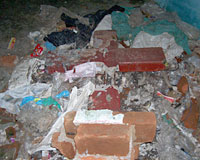Where kindness incites the Hindu killers
by - 14th January 2009
 The 50-year old Church of North India hospital in Diptipur is just fifteen kilometres from the devastated and now abandoned orphanage at Kunthpali.
The 50-year old Church of North India hospital in Diptipur is just fifteen kilometres from the devastated and now abandoned orphanage at Kunthpali.
That’s where 18-year-old Hindu hostel warden Rajni Majhi was burned to death, trying to defend the Catholic Father, who founded it, from a Bajrang Dal mob targeting Christians.
Christians in neighbouring Diptipur – an old mission station meaning ‘Place of Light’ – now believe they are next if violence flares again.
Eight burly Nepalese militias – the Central Reserve Police – are indefinitely stationed on central government orders within the hospital compound, while a surgeon continues restoring sight to up to 200 of the poorest people from surrounding villages.
Diptipur Christian Hospital is unique in that it sends teams into the villages to find the blind or partially sighted. These are mostly elderly people, who for want of a cataract operation that takes ten minutes and is undertaken without charge, have lost all dignity, are unable to work, or even go into the fields to relieve themselves without help.
The surgeon is 28-year old Jacob Koshy from Kerala, who performs the operations in the rudimentary but fully equipped operating theatre for half the salary he could command in Hyderabad where he normally lives with his family. His fee for this camp is being paid by Second Sight, a UK-based NGO.
Yet Diptipur has a death sentence hanging over it – and was forced by police to close for three months after the killing and destruction that swept through this deprived part of India last summer.
The violence followed the murder by Maoists of a local Hindu leader, Swami Laxmanananda Saraswati for which Christians were maliciously blamed.
A mob of 200 alcohol-fuelled youths first attacked and partially destroyed the church and manse in Padampur.
Shouting ‘Jai Ram’ – ‘Victory to Ram’, the battle cry of the deadly Rastriya Swayamsevak Sangh (RSS), they heaved the cross off its plinth and through the tiled roof.
They then moved onto the orphanage in Kunthpali, savagely beating Fr. Edward Sequiera from Mangalor, a member of the Society of the Divine Word (SVD).
Altogether forty-seven people have been killed and eleven churches totally or partially destroyed in this one remote diocese of Sambalpur, an eight-hour drive along pitted roads from the capital Bhubaneswar.
The RSS is the parent body of the Bharatiya Janata Party, the major ruling political organization in India – and holds the balance of power in Orissa with the Biju Janata Dal which is attempting to dissociate itself from a party directly implicated in murder.
Their methods are ruthless, targeting Christians, and killing administrative officials in a bid to dominate through terror the swathe of districts that lie between Malkangiri, now effectively a lawless district, and Bhubaneshwar, the state capital.
The Christian district of Sambalpur and Khandamal lies in their path.
The Supreme Court in Delhi has forbidden the unilateral withdrawal of troops from this area. Without them there is pitiful lack of security for people who have lived peacefully for centuries with their assailants.
Many are known to them, but are incited to settle old scores by outsiders, many of whom come from Bihar. The Bajrang Dal, or youth wing of the nationalist Hindutva movement, is a terror organization which the government has so far refused to ban. It was the Bajrang Dal that burned missionary Graham Staines and his two young sons alive in their four-by-four in southern Orissa in 1999.
The Christians we met have not retaliated, and are saddened by the deterioration in relationships with people they’ve known all their lives. They do not defend themselves. All the Christians in Diptipur fled to the nearest town or to Hindu neighbours, and the hospital closed for three months. It has no walls, or gates. Like the orphanage, there is no protection against the vicious misuse of kerosene once the soldiers leave.
Hospital director, Dr Ipsita Deep, 25, a beautiful and impressive local dalit girl, says simply: 'What can we do if they attack?’
Yet the village pastor who lives in the huge and run-down former mission house across from the hospital with his wife has asked for a transfer.
‘The pastors are the targets. I am very afraid.’
The Bishop of this 35,000-strong Church of North India (CNI) Diocese of Sambalpur, Rt Revd Dr CK Das must wrestle with the problem. A tall scholarly man who continues to wear the prominent crucifix of his office says: 'When a transfer takes place, you get a bad effect. If he is unwilling to stay, someone else is not willing to come.
‘Why are they afraid? We must have our faith in God and in his security.’
The loss to the region if Christians abandon their villages for the desperate struggle on the margins of the new metropolises is plain to see. Across the road from the pastor’s house, a group of animated and elderly patients, now sporting incongruous sunglasses to protect tender post-operative eyes, waits for the bus back to their villages.
One elderly crone, fingering the chiffon dupatta at my neck, exclaims at the beauty of its colour which she can now see after years of total blindness, says, in Oriya, the local dialect: ‘Once we were dead. Now we have life.’
That may be true for her, but for the hospital it is a different matter. The enforced three-month closure meant that patients stopped coming altogether.
The eye camp is an attempt to send a message to the people that it’s once more open for business. In the current climate, that’s little short of a miracle.
Read Jenny Taylor’s reports from Orissa all this week.
Coming next: Refugee camps in India’s nuclear age.
- Log in to post comments
